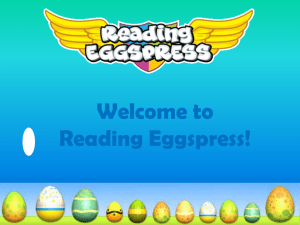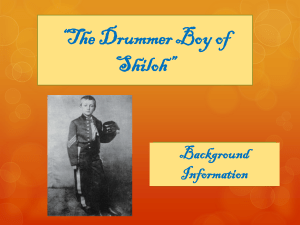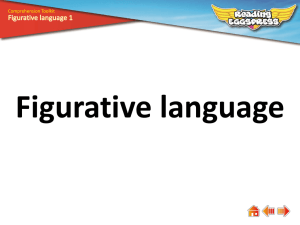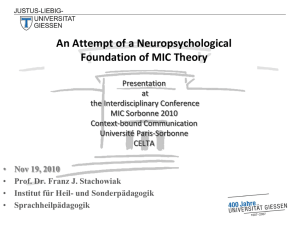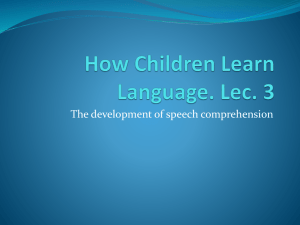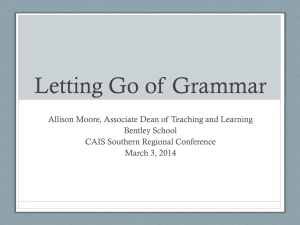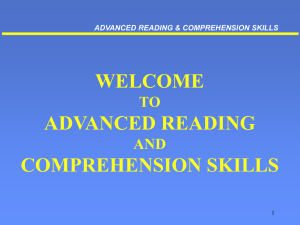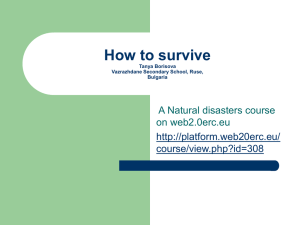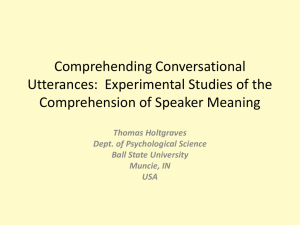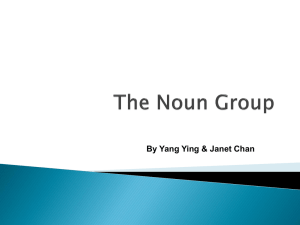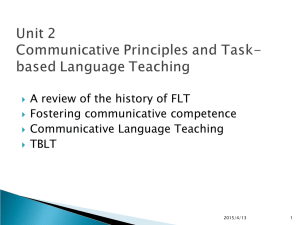Chapter 8 - Communication Disorders
advertisement
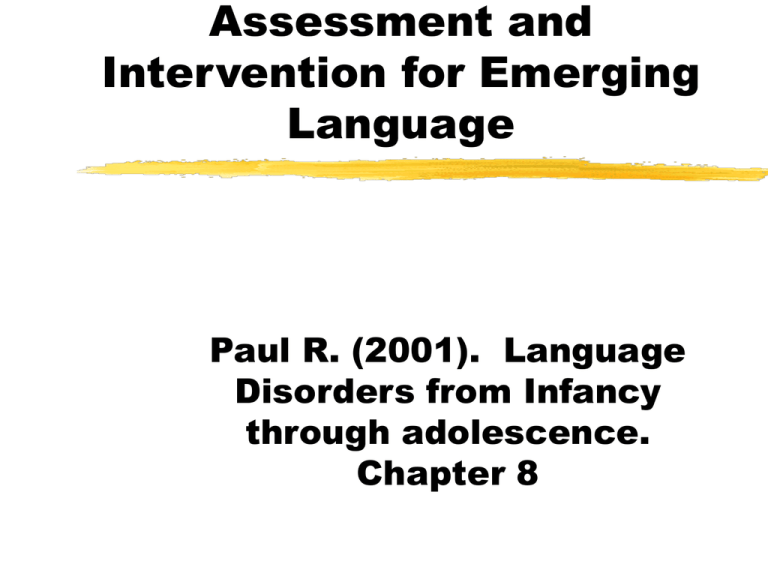
Assessment and Intervention for Emerging Language Paul R. (2001). Language Disorders from Infancy through adolescence. Chapter 8 What is emerging language stage (EL)? For normally developing children, corresponds to toddler age range Approx - 18 - 36 months Who might be at the EL stage? Children between 18-36 mos with no known risks but parents or others are concerned Children between 18-36 mos with known risks Older children with severe disabilities To see them or not to see them…that is the question. Children under 3 with intact cognitive, preverbal communicative, and sensory capacities with no risk factors - low priority Children with cognitive deficits, hearing impairment or chronic OM, preverbal communication problems, risks pre or perinatally - should be seen But remember... Therapy may facilitate development in “normal” slow talkers Children with later language disabilities often have histories of delayed language development Normal Development E xp re ssio n V o ca b u la ry Com p. W e th e rb y e t a l. (1 9 8 8 ); P a u l & S ch iffe r, (1 9 9 1 ) 18 m os – 2 co m m u n ica tive a cts/m in 2 4 m o s - 5 C A s/m in N e lso n (1 9 7 3 ) 1 8 m o s – co m b in in g 2 w o rd s M ille r (1 9 8 1 ) 2 4 m o s – M LU – 1 .5 -2.4 F e n se n e t a l. (1 9 9 0 ) 1 8 m o s – 1 1 0 w o rd s 2 4 m o s – 3 1 2 w o rd s 3 0 m o s – 5 4 6 w o rd s C h a p m a n (1 9 7 8 ) 1 8 -2 4 m o s – u n d e rsta n d 2 -3 w o rd s/se n te n ce th e y h e a r Assessment of Communication in EL Multidisciplinary and Transdisciplinary assessment Play assessment Communication assessment Play Assessment Want to ensure child is at a developmental level consistent with communication development Relationships exist between play and language development Provides a more holistic picture of the child Assessing Play Communication and Symbolic Behavior Scales (Wetherby & Prizant, 1990) Play Scale (Carpenter, 1987) parent plays with the child see Table 8-1, 8-2 p 251 McCune (1985) child is given a set of toys and behaviours are analysed (see Table 8-2) Symbolic Play Test (Lowe & Costello, ‘76) Communication Assessment Rating Scales see Table 8-3, p. 253-254 Communication and Symbolic Behavior Scales (Wetherby & Prizant, 1990) observe parent and child in various interactions rates performance in five areas Informal examination of communication functioning Informal Examination of Communication Function Assessing Communicative Intention Assessing comprehension Assessing Production Assessing Communicative Intention Range of communicative functions Proto-imperatives Requests for objects Requests for actions Rejections or protests Proto-declaratives Discourse functions Requests for Information Acknowledgements Answers Assessing Communicative Intention (cont’d) Frequency of expression of intentions Forms of communication (e.g. gestural, vocal) Assessing Communicative Intent: Worksheet Table 8-4, page 256 Communicative Act: Must be directed at adult. Child must look at or address the adult directly in some way. Must have an effect on influencing the adults’ behaviour/focus of attn or knowledge. Child must be persistent in the attempt to convey the message if the adult does not respond Assessing Comprehension Standardized language tests/scales PPVT-III, Sequenced Inventory of Communicative Development (SICD), Receptive Expressive Emergent Lang Scale (REEL). Comprehension Activities: Understanding Single Words A collection of six to eight items Give me… or Where’s… Can assess body parts Assess verbs Comprehension of single words is normal for 12-18 mos. What if they don’t? Comprehension activities: Two word comb’s (18-24m) Action-object (use words understood at single-word stage) choose unusual combinations such as “kiss the apple” “hug the shoe” Comprehension Activities: Beyond 2-words (24-36 m) Agent-action-object instructions Rely on probability Start with vocabulary from earlier stages and then move on see Table 8-6 Comprehension beyond 36 months Can be tested using formal comprehension measures such as PPVTIII, TACL-R, Miller-Yoder Test of Grammatical Comprehension, CELF-P Comprehension Findings: What do they mean? If comprehension is superior to production better outcomes If comprehension is poor: need to include comprehension component in therapy as well as expressive component Assessing Espressive Language Speech motor development Speech sample/phonetic repertoire Phonological skills Lexical production/Vocabulary Semantic-syntactic production Vocabulary (Lexical Production) Expect a child to have at least 50 words and some two-word combinations in the 24-36 month stage Rating scales MacArthur Communicative Development Inventories (Fenson et al., 1993) Language Development Survey (Rescorla, 1989) Semantic syntactic production Children don’t begin to combine words until vocabulary size is approx 50 words To assess semantic-syntactic production: Determine the relative frequency of word combinations Evaluate semantic relations expressed Table 8-7 (Browns Semantic Relations) Variety of relations Advanced relations Normal toddlers express 8-11 different semantic relations Decision making based on assessment information See Paul’s decision tree on p. 253 (Fig. 8.2) Intervention: Goals, Procedures & Context Four main areas that may be targeted: Functional and symbolic play skills Using intentional communication Language comprehension Production of sounds, words, and word combinations Functional and Symbolic Play Skills Step1: Establish reciprocal behaviour and anticipatory sets (e.g. peek-a-boo) Step 2: Model early forms of symbolic play and encourage imitation Step 3: Model play routines like pretending to give the doll a bath, meal time, store games Developing Intentional Communicative Behaviours Want children to initiate communication #1: Communication temptations can model first with the parents (e.g. hand Mum a container and she hands it back to therapist and indicates ““take the lid off” or says “help”. Then hand container to the child) #2: Milieu model place things out of reach and get the child to ask for it or draw the child’s attention to it and wait for a response Developing Intentional Communication (cont’d) #3 : Use routines or script therapy and then violate the routines #4 : Respond as though the child is showing intent #5: If range of intent is limited, increase use of proto-imperatives and declaratives model the behaviour pretend not to notice something that the child is interested in and wait for them to get your attention Developing Intentional Communication (cont’d) If child has adequate intentions but is only using gesture -->increase vocalising Model the target response Withold response or pretend not to notice until some vocal behaviour produced Developing Intentional Communication (cont’d) If the child is using maladaptive behaviour: immediately provide an alternative form of communication (e.g. I see you want it. Point to it and I’ll give it to you.) might need to actually take the child’s hands and demonstrate the action Developing Receptive Language Indirect Language Stimulation (parent training) self-talk/parallel talk imitations expansions extentions build-ups and breakdowns recast sentences labelling see box 8-3 Developing sounds, words, and word combinations Increasing phonological skills expand the repertoire of sounds use developmental information Developing a first lexicon choose words based on normative data some words should be nouns for labeling other words should be chosen for expressing other functions see Table 8-10 Developing sounds, words, and word combos (cont’d) Developing a first lexicon (cont’d) MacDonald suggested choosing words that are within the child’s interests Consider the child’s phonetic repertoire choose words with sounds in the child’s repertoire early words may be limited to CV and CVC shapes How should we teach first words? Child centered approach clinician provides many models use play contexts and don’t require response Hybrid approach milieu teaching place objects out of child’s reach script therapy engage in a verbal routine, once it is overlearned, either violate it or use a cloze technique How should we teach first words? Hybrid approaches focussed stimulation set up the situation so that you are modeling the specific vocabulary you want to teach provide lots of opportunities for the child to produce it use recasts, expansions, extensions, etc. Clinician-directed may be suitable for older children Developing word combinations Word combinations express semantic relationships Client-centered play situation-when the child produces a one-word utterance, the clinician expands it to a two-word phrase Developing word combinations Hybrid approaches Schwartz et al.(‘85) - vertical structuring Whitehurst et al.(‘91) - see box 8-5 milieu approaches put something out of child’s reach - “get X” focussed stimulation script therapy perhaps use a book or song-play that has two words Developing word combinations (cont’d) Clinician-directed approaches Leonard (‘75) use a puppet and the puppet describes what’s happening in the picture get the child to tell the puppet what’s happening and to “talk like” the puppet MacDonald et al. (‘74) - Environmental Language Intervention (ELI) parent works on goal for 5 min in 3 conditions sessions are three times/week see Box 8-6
